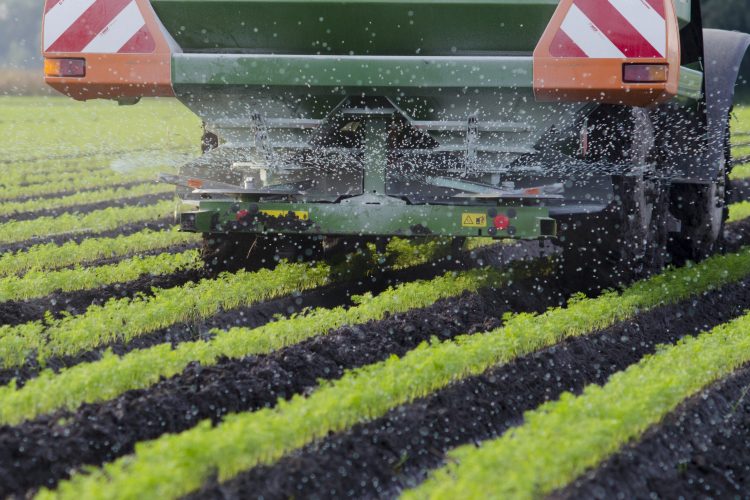High fertiliser profits “likely fuelling food price inflation”, finds ECIU
- Like
- Digg
- Del
- Tumblr
- VKontakte
- Buffer
- Love This
- Odnoklassniki
- Meneame
- Blogger
- Amazon
- Yahoo Mail
- Gmail
- AOL
- Newsvine
- HackerNews
- Evernote
- MySpace
- Mail.ru
- Viadeo
- Line
- Comments
- Yummly
- SMS
- Viber
- Telegram
- Subscribe
- Skype
- Facebook Messenger
- Kakao
- LiveJournal
- Yammer
- Edgar
- Fintel
- Mix
- Instapaper
- Copy Link
Posted: 14 August 2023 | Grace Galler | No comments yet
Analysis from ECIU has found that a 500 percent jump in fertiliser company profits is a “likely” cause of food price inflation.


According to a recent study by the Energy & Climate Intelligence Unit (ECIU), high food price inflation has “likely” been fuelled by a 500 percent increase in fertiliser company profits.
The research analysed fertiliser prices in 2022 (relative to 2020), with the ECIU also highlighting that there were food price hikes of 18.9 percent in the year leading up to May 2023.
With fertilisers commonly being made from natural gas, the ECIU observed that “record gas prices in 2022 helped push fertiliser prices to an all-time high”. In fact, it cited ammonium nitrate as the most commonly used fertiliser and found it to cost £719 per tonne in 2022, a £502 increase from £217 per tonne in 2020.
While ECIU has said that prices have started to drop down in 2023, it claimed that the higher prices have bumped the fertiliser bill for farmers a notable £1.17 billion higher in 2022 than it was in 2020. In fact, it found that “farmers have still spent £479 million more this year than at the same point three years ago”.
Even with high fertiliser costs, data from the UK Government’s Department for Environment, Food and Rural Affairs (DEFRA), has revealed that UK farmers still made a profit upwards by £813 million (13.5 percent). Meanwhile, during the same time frame, The Guardian reported that retailers “probably [weren’t] profiteering”, with ECIU claiming that “higher fertiliser costs were likely passed onto the consumer” instead.
High food inflation persists while overall inflation dips to 8.7 percent
New Food has reported on soaring food prices in the UK over the last year, however, in its own report, ECIU found that during this time fertiliser supply companies have made “unprecedented profits”. Looking at data, IBIS World has found three of the main companies that supply to the UK market (CF Industries, Yara and Origin Enterprises) made a combined net profit of £5.45 billion in 2022, considerably higher than the £909m profit made in 2020.
Commenting on the impact of fertiliser company profits on inflation, Pawel Kisielewski, CCm Technologies CEO said: “The gas price crisis has increased fertiliser costs for farmers feeding through to higher prices for the public.”
“It doesn’t need to be like this,” continued Kisielewski, before suggesting: “There are waste streams here in the UK that can be transformed into fertiliser rather than relying on processes utilising virgin gas. This would break the link between gas prices and conventional fertilisers. Alternatives exist, higher fertiliser prices don’t need to mean higher food prices for consumers.”
Meanwhile, Tom Lancaster, Head of Land, Food and Farming at the Energy and Climate Intelligence Unit (ECIU), noted: “With retailer profits holding steady and farmers slightly in the black, it is inevitable that the consumer is footing the bill again, this time in the form of record profits for some of the world’s biggest fertiliser companies driven up by the gas crisis.
“With the Bank of England predicting food price inflation to remain high, the effect of high gas prices on our weekly shop is lingering well into 2023,” continued Lancaster.
Of the three main fertilisers UK farmers use, analysis from ECIU has found that “farmers used 90 percent of the total 2023 usage by the end of May”, something it says means that “any further falls in the fertiliser price in the rest of the year are unlikely to lower food prices”.
Sharing his stance, Martin Lines, UK Chair of the Nature Friendly Farming Network said: “With input prices increasingly volatile, farming with nature helps reduce my fertiliser bill, whilst maintaining my yields.
“As a result I’m less dependent on fossil fuel inputs and less exposed to global price shocks. Healthy soil is more resilient to flooding and drought as well, making me more able to adapt to the worst impacts of climate change.”
Related topics
Environment, Food Security, Research & development, Supply chain, The consumer, Trade & Economy
Related organisations
Energy & Climate Intelligence Unit (ECIU), Ibis World, UK Government









